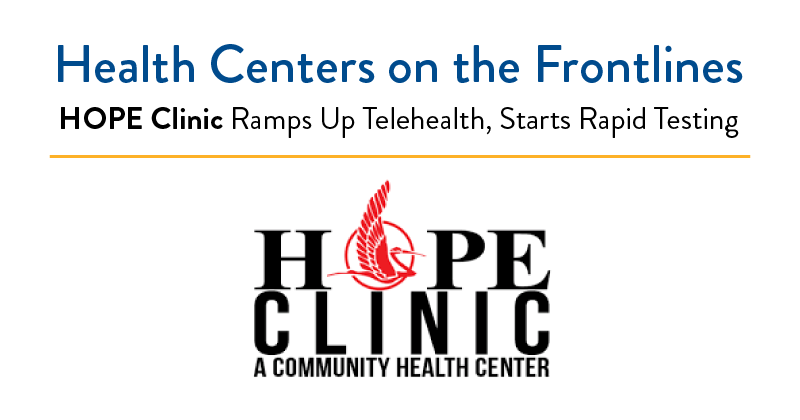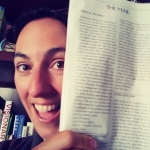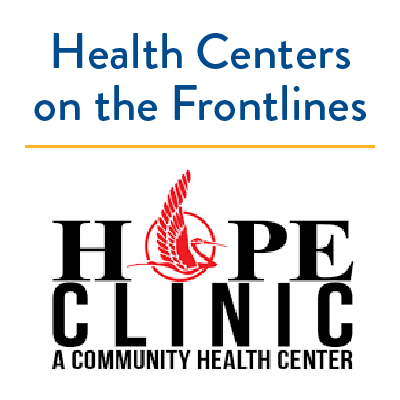Health Centers on the Frontlines: HOPE Clinic Ramps Up Telehealth, Starts Rapid Testing

In Houston, Texas, HOPE Clinic is living up to its name. The large urban community health center rapidly ramped up its telehealth services as the COVID-19 pandemic struck, and now almost 20 percent of its visits are virtual or by phone. Building on the telehealth structures they already had, HOPE Clinic virtual appointments intersect with the EHR, providing a streamlined virtual encounter in which clinicians can document as the appointment unfolds.
“And we haven’t let anybody go,” added Andrea Caracostis, MD, MPH, Chief Medical Officer of HOPE Clinic. Her “command center”, a core team of clinicians, are meeting daily to debrief and prepare for the next day. “We look at supplies and staffing, we review the [COVID-19] positives and the screenings we did, and we plan what’s going to happen for the next couple of weeks. And, we start rolling out what needs to happen to make that a live process.”
But, despite the significant progress to serve patients, the process has been far from rosy, and Dr. Caracostis believes the longer-term outlook is tenuous at best. At the onset, some dental, behavioral, and vision staff that were unable or unwilling to be retasked were furloughed. Additionally, starting last week, all staff went to 32 hours per week. This was a necessity based on social distancing. “We see a lot of patients every day, and our clinics are crowded. We needed to reduce the staffing,” Dr. Caracostis admitted. The savings, Dr. Caracostis said, are also critical. Health centers “will not feel the financial pinch until July and September, when billings are so low and you haven’t been able to collect. We all have reserves, and we have the federal government money coming, but today is the day to save,” she said. She believes cuts will be harder to enact and more painful to incorporate later in the year: “Today, when people are motivated to do the big sacrifices, is the time to do it.”
Dr. Caracostis worries about patients for which telehealth is unattainable, due to poor internet connections, limited cell service, or insufficient funds to pay for service or data on cell phones. These are the patients who may lack other key resources and networks, putting them at a higher risk for illness and, as is evident with the telehealth rollout, less access to care. While the reimbursement rate for a HOPE Clinic telehealth appointment is the same as an in-person visit, the payment for phone visits is significantly less, but HOPE continues to serve many patients over the phone regardless, to widen care access.
Dr. Caracostis says that HOPE Clinic was perhaps more prepared for the pandemic because of its previous efforts at bolstering its emergency preparedness. “We have a lot of hurricanes, so we’ve been working on emergency preparedness for a long time,” she said. HOPE Clinic’s “doctor in a box,” called the MedPod, a suitcase of tools connected to the telehealth system, is one example of a preparedness measure they already had ready when the pandemic struck. It is currently being used in one of HOPE Clinic’s sites where they haven’t been able to hire a family doctor. The medical assistant can connect to a doctor at another HOPE Clinic site and utilize the instruments in the box -- a smart otoscope, for example -- to complete an exam or screening, with the guidance of a doctor. The MedPod is allowing the site to continue to see patients even without a doctor on-site, expanding care to regions that lack sufficient access to health care at this critical moment.
And HOPE Clinic is expanding services as well. Starting this week, they are opening a COVID-19 screening unit. HOPE had held off on providing a publicized screening option for fear of undermining the local health department’s screening process and confusing the public on where to go when tests are limited. As the rapid test rolls out, HOPE Clinic is shifting gears to provide the test and expand their role in screening. “More tests are available, so it’s time to roll it out to measure true exposure” in the community. “Understanding exposure is going to be critical in the next few weeks, and health centers need to jump on this; however, it is important to make sure we are using a sensitive test that is FDA approved. There are many tests out there that are not reliable,” she said.
The rollout, she said, is yet another hurdle that HOPE Clinic will need to surpass. “We have a lot to learn about the test,” Dr. Caracostis added, then noted -- perhaps more a summary of the entire pandemic response, than just of the newest initiative to provide testing -- “we definitely have to learn as we go.”
Like what you see? Amplify our collective voice with a contribution.
Got some good news to share? Contact us on our social media pages above.
Return to the main blog page or sign up for blog updates here.
- Log in to post comments

